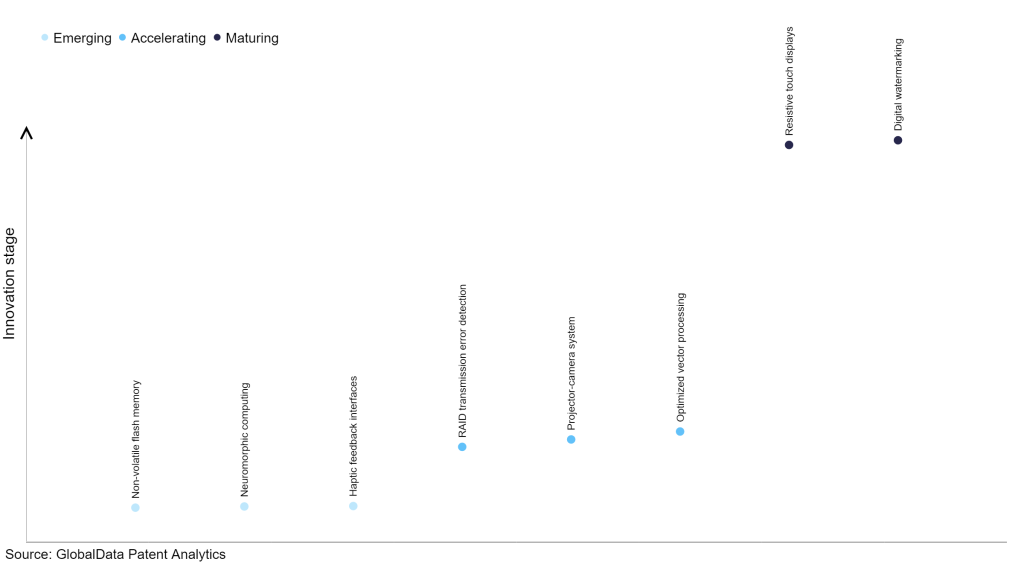The technology industry continues to be a hotbed of patent innovation. Activity is driven by the advancements in display technology, the demand for enhanced image processing in fields like medical imaging and computer graphics, and the proliferation of high-resolution content creation, and growing importance of technologies such as deep learning, neural networks and generative adversarial networks (GANs). In the last three years alone, there have been over 1.5 million patents filed and granted in the technology industry, according to GlobalData’s report on Innovation in technology: digital image interpolation. Buy the report here.
However, not all innovations are equal and nor do they follow a constant upward trend. Instead, their evolution takes the form of an S-shaped curve that reflects their typical lifecycle from early emergence to accelerating adoption, before finally stabilizing and reaching maturity.
Identifying where a particular innovation is on this journey, especially those that are in the emerging and accelerating stages, is essential for understanding their current level of adoption and the likely future trajectory and impact they will have.
185+ innovations will shape the technology industry
According to GlobalData’s Technology Foresights, which plots the S-curve for the technology industry using innovation intensity models built on over 1.6 million patents, there are 185+ innovation areas that will shape the future of the industry.
Within the emerging innovation stage, non-volatile flash memory, neuromorphic computing, and haptic feedback interfaces are disruptive technologies that are in the early stages of application and should be tracked closely. RAID transmission error detection, projector-camera system, and optimized vector processing are some of the accelerating innovation areas, where adoption has been steadily increasing. Among maturing innovation areas are resistive touch displays and digital watermarking, which are now well established in the industry.
Innovation S-curve for the technology industry

Digital image interpolation is a key innovation area in technology
Digital image interpolation involves augmenting the resolution or dimensions of a digital image by approximating the absent data points that lie between existing pixels. It is a widely employed method in image processing to elevate image clarity and refine visual intricacies, achieved by generating additional pixels using information from neighboring pixel values.
GlobalData’s analysis also uncovers the companies at the forefront of each innovation area and assesses the potential reach and impact of their patenting activity across different applications and geographies. According to GlobalData, there are 1990+ companies, spanning technology vendors, established technology companies, and up-and-coming start-ups engaged in the development and application of digital image interpolation.
Key players in digital image interpolation – a disruptive innovation in the technology industry
‘Application diversity’ measures the number of applications identified for each patent. It broadly splits companies into either ‘niche’ or ‘diversified’ innovators.
‘Geographic reach’ refers to the number of countries each patent is registered in. It reflects the breadth of geographic application intended, ranging from ‘global’ to ‘local’.
Patent volumes related to digital image interpolation
| Company | Total patents (2010 - 2022) | Premium intelligence on the world's largest companies |
| Silicon Motion Technology | 8 | Unlock Company Profile |
| Fujifilm | 26 | Unlock Company Profile |
| Qualcomm | 7 | Unlock Company Profile |
| Spreadtrum Communications (Shanghai) | 8 | Unlock Company Profile |
| Texas Instruments | 7 | Unlock Company Profile |
| BYD | 4 | Unlock Company Profile |
| Apple | 24 | Unlock Company Profile |
| Centre National de la Recherche Scientifique | 2 | Unlock Company Profile |
| JVCKENWOOD | 3 | Unlock Company Profile |
| MegaChips | 11 | Unlock Company Profile |
| Olympus | 27 | Unlock Company Profile |
| Mitsubishi Electric | 4 | Unlock Company Profile |
| Silicon Hive | 4 | Unlock Company Profile |
| Intuitive Surgical | 4 | Unlock Company Profile |
| Canon | 32 | Unlock Company Profile |
| Realtek Semiconductor | 3 | Unlock Company Profile |
| Basler | 18 | Unlock Company Profile |
| Samsung Electro-Mechanics | 3 | Unlock Company Profile |
| Sony Group | 58 | Unlock Company Profile |
| STMicroelectronics | 3 | Unlock Company Profile |
| Toshiba | 2 | Unlock Company Profile |
| Intel | 14 | Unlock Company Profile |
| GoPro | 16 | Unlock Company Profile |
| Blackmagic Design | 10 | Unlock Company Profile |
| SZ DJI Technology | 8 | Unlock Company Profile |
| INUITIVE | 4 | Unlock Company Profile |
| Oppo | 3 | Unlock Company Profile |
| Raytheon | 2 | Unlock Company Profile |
| Guangdong Oppo Mobile Telecommunications | 48 | Unlock Company Profile |
| Centre National Research Scientific | 6 | Unlock Company Profile |
Source: GlobalData Patent Analytics
Among the companies innovating in digital image interpolation, Guangdong Oppo Mobile Telecommunications is one of the leading patents filers. The company’s patents are aimed at describing the control technique for an electronic device involves directing an image sensor to produce both a combined image and a color-blocked version of the same scene. A specific area is identified in the combined image based on user input. The color-blocked image is transformed into an imitation image, while the combined image is converted into a restored version. In the color-blocked image, a designated region is processed using a first interpolation method, corresponding to the identified area. Meanwhile, in the combined image, a different area outside the identified region is processed using a second interpolation method. The final imitation image is generated by merging the first imitation image with the restored version. This method is applicable to an electronic device. Other prominent patent filers in the space include Samsung Group and Tencent.
In terms of application diversity, Samsung Group leads the pack, while Tencent and Baidu stood in second and third positions, respectively. By means of geographic reach, Stryker held the top position, followed by X and The Saudi Public Investment Fund.
Digital image interpolation, by estimating missing data points between existing pixels, allows for the augmentation of image resolution and size. This technology finds extensive applications in fields like computer graphics, medical imaging, and computer vision. It enables the creation of higher-quality images, facilitating clearer visual representations and improving the effectiveness of various image processing tasks. Additionally, digital image interpolation is instrumental in tasks like super-resolution, image inpainting, and edge-preserving techniques, making it a critical tool in modern image processing applications.
To further understand the key themes and technologies disrupting the technology industry, access GlobalData’s latest thematic research report on Technology.
Data Insights
From

The gold standard of business intelligence.
Blending expert knowledge with cutting-edge technology, GlobalData’s unrivalled proprietary data will enable you to decode what’s happening in your market. You can make better informed decisions and gain a future-proof advantage over your competitors.







